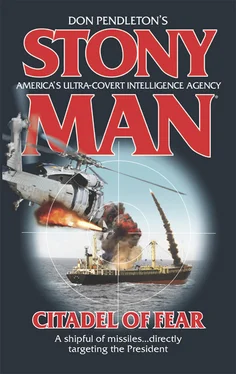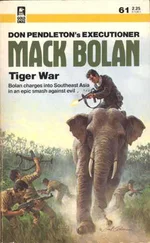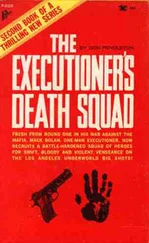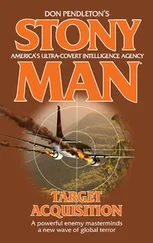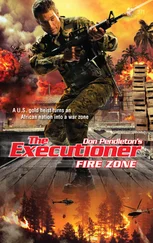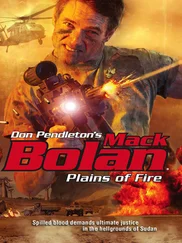“How much?”
“We talk money later. Now? I will be needing to lose handcuffs and get gun.”
“One condition.”
“And, so?”
McCarter nodded toward Hawkins. “His name is Hawk.” He tossed the Swedish M-40 pistol onto the table. “Uncuff him.”
The War Room
Aaron Kurtzman observed as T. J. Hawkins operated on the Unmanned Aerial Vehicle thousands of miles away in Scandinavia. Kurtzman would have preferred to have done the surgery himself, but security protocols dictated the little UAV helicopter traveled no farther until they could make sure they weren’t bringing a Trojan horse into the Farm’s precincts.
Kurtzman secretly wished Hermann “Gadgets” Swartz was in the operating theater, but Hawkins wasn’t bad. The UAV was a standard quad-motor helicopter with four equidistant rotors on stalks sticking out of the main body. This one had a very powerful and sophisticated camera that was night-vision capable. Hawkins had separated the motors and the camera; they were amazing pieces of technology.
“Here we go…”
Gummer leaned in carefully. He was the team’s explosives expert and this was the point where everyone wondered if the UAV would blow sky-high. Hawkins carefully separated the two halves of the fuselage as if it were the shell of a crab.
Kurtzman leaned forward in his wheelchair and peered at the feed from Sweden on his screen.
The guts of the UAV were extremely interesting.
Much like a crab shell, nothing was attached to the top. All the good stuff was attached to the bottom half.
Hawkins looked into the camera. “Bear, I don’t know what half this stuff is.”
Gary Manning sat back, nodding to himself. “I don’t see a booby trap. If there are any explosives in there, they are tiny and made to wipe the equipment instead of kill anyone who might be tampering.”
“Wait a minute, before you two touch anything else.” Kurtzman took control of the camera on his end and began panning and scanning the UAV’s internal organs.
The power supply system was easy to spot and very impressive. It was a flat stack and Kurtzman suspected this UAV would have double the range and endurance of a standard commercial model of comparable size. He had to admit he had never seen a CPU like the one he beheld mounted in a UAV like this. Most similar models were equipped with a simple GPS that allowed them to return to their launch point if they lost contact with their human operator. The sophistication of this drone’s CPU implied to the Stony Man cybernetics whiz that the drone was capable of making a number of decisions autonomously and could operate in independent search, patrol or mapping functions.
Kurtzman was also willing to bet that this machine was capable of being operated by, or cooperating with, other autonomous drones operating as autonomous units. In effect, this baby was capable of engaging in independent small- and large-unit actions without the benefit of a human operator in control.
It was an incredibly sophisticated piece of machinery.
Kurtzman leaned back in his chair. It was a very strange thing to be shot down out of the sky during an engagement with Russian mafiya thugs. Of course the mafiya thugs had showed up with antiaircraft artillery. It all led to the inescapable conclusion that there was a much larger game afoot.
Hawkins pointed his screwdriver at a small, yellow, rectangular casing that almost seemed off in a corner by itself. It didn’t appear to be connected to the UAV’s power supply, CPU, engine or guidance units. “What do you figure the little yellow box is?”
“I figure that little yellow box is the little black box.”
“A flight recorder?” Manning offered. “On a little rig like this?”
“You’re right,” Kurtzman agreed. “You don’t usually see that on a UAV this size. But it’s not attached to anything and it hasn’t blown up. A drone is the same as any other vehicle. You don’t want the flight recorder attached to anything else in the system. You want it to independently record what happens in case the vehicle gets lost, shot down, captured or, most important, hacked and hijacked.”
“So it’s on right now?” Hawkins asked.
“I suspect its transponder is pinging away.”
As a demolitions man, Manning knew something about electronics. He eyed the little yellow box. “So the bad guys know where we are? Even here?”
“Depends on the range. That is a pretty small unit and you have flown it across the Baltic. It’s not like you left it where it fell in Gdansk. Then again? Just about everything inside that rig appears to be about ten times more powerful than any standard, comparable commercial model UAV. Heck, a lot of its electronics are more sophisticated than similar-size stuff the United States military issues to our troops, including Special Forces. This fellow is not standard issue anywhere. It’s made to look like a commercial rig, but it was made custom from top to bottom, to customer specifications, and that customer had money to burn.”
“So the bad guys know where we are?” Hawkins asked again.
Kurtzman made a judgment call. “Normally, I would say no, unless of course the bad guys have their own satellite talking to it.”
McCarter leaned in to the conversation. “You think these guys have their own satellite?”
“I would bet they have one. Or, given the level of sophistication, they can access someone else’s satellite and the owners don’t know about it.”
Hawkins tried one more time. “So the bad guys know where we are?”
“Oh, I’d bank on it,” Kurtzman confirmed. “Speaking of which, did you get the guns?”
Hawkins had taken the elite trajectory from United States Army to United States Army Ranger to Delta Force before he had taken a meeting with Mack Bolan and company. All of his life, guns were artillery pieces. Firearms were weapons. He had given up trying to explain this to Kurtzman. Hawkins often had to remind himself that despite the man’s utter brilliance, Kurtzman was, and always would be, a civilian. “The guns arrived, Bear. Swedish steel is good steel.” Hawkins made a face. “Too bad they’re fifty years old…”
“Short notice?” Kurtzman vaguely milled his hands. “Sweden?”
“They’re charmingly retro,” quipped Calvin James from where he sat in an armchair assiduously cleaning and oiling his weapon. “I’ve met some old-timers at the SEAL meets who’ve told stories about being issued Swedish Ks.” He made a face that matched Hawkins’s. “In Nam—”
“Retro is right,” Hawkins grunted.
The Swedish K submachine guns had no optics, laser designators, suppressors or tactical lights. They looked as though they belonged in a Bond film; nothing later than early Roger Moore, and Sir Roger probably would have scowled at them. They only operated on rock and roll and didn’t even have a safety. Though that part Hawkins perversely kind of liked. He also kind of liked the fact that the models the CIA had procured were so old they had the original adapter for Finnish 50-round magazines. Hawkins got back to the matter at hand. He turned to McCarter. “So, boss. Do I do anything about the black box or not?”
McCarter leaned over the table and peered at the little yellow question of the day. “Bear, what do you think?”
“My guess is they have been able to track you, and they had all day to cross the Baltic or organize something in your neighborhood. If you want to move, they’ll be able to track you. Maybe you want to do that and set a trap? Or you could remove it, put it on a train to nowhere and send the bad guys on a wild-goose chase, then maybe we can take a stab at tracking them.”
Читать дальше
